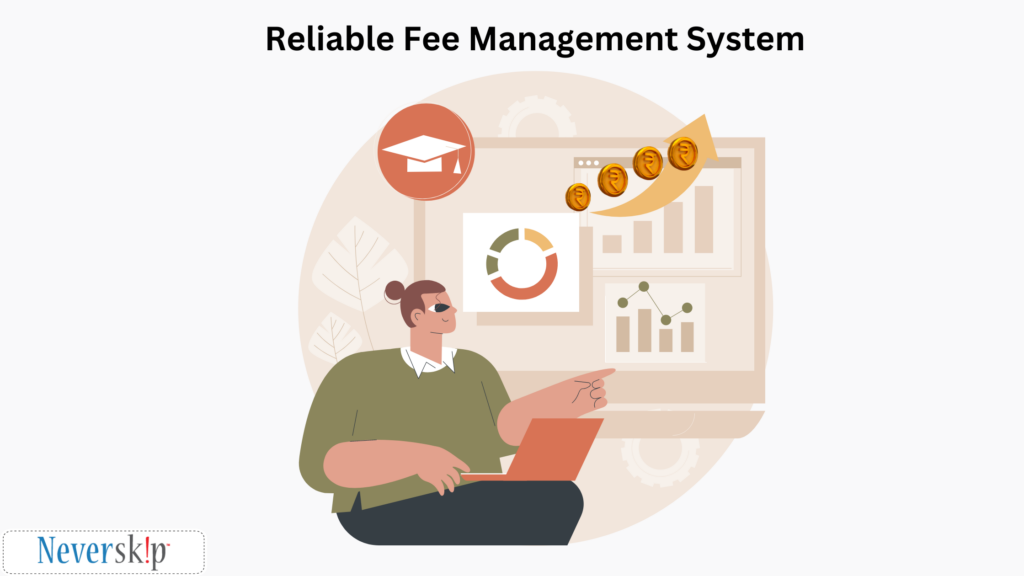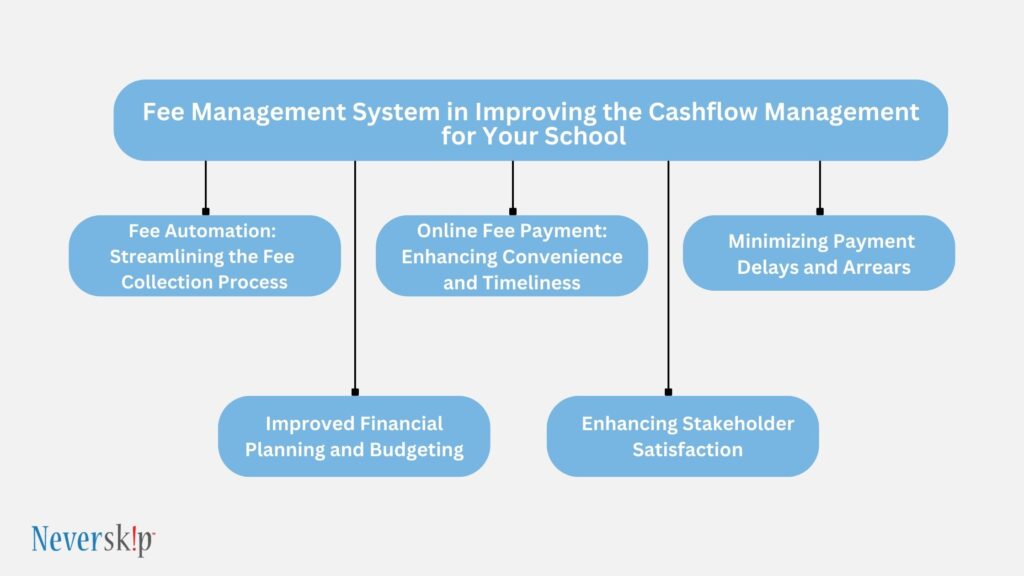In any educational institution, maintaining a healthy cash flow is crucial for its smooth functioning and growth. Schools are no exception to this fundamental principle.
A well-organized fee management system can play a pivotal role in ensuring consistent cash flow, contributing to the overall financial stability and success of the school. In today’s challenging economic landscape, teachers and administrators recognize the significance of optimizing cash flow to meet various operational expenses, provide quality education, and invest in infrastructure and educational resources.
By streamlining fee collection processes, automating payment tracking, and enhancing transparency, schools can effectively reduce payment delays and arrears, leading to a more efficient financial system.
A well-implemented fee management system can prove to be a valuable asset to your school, not only in terms of financial management but also in elevating the educational standards and fostering an environment of academic excellence.
Let’s delve deeper as we start from the basics for a better understanding.
What Is a Fee Management System?

A Fee Management System is a comprehensive software solution designed to handle and streamline the entire fee-related processes in educational institutions, such as schools, colleges, and universities.
It serves as a centralized platform to manage all aspects of fee collection, payment processing, and financial tracking. This system automates and simplifies various tasks, including generating fee structures, invoicing, fee receipt generation, tracking payment histories, and issuing reminders for pending payments.
The Fee Management System aims to bring efficiency and transparency to the fee administration process, benefiting both the institution and its stakeholders. For educational institutions, it provides real-time insights into fee collections and outstanding dues, enabling better financial planning and budgeting.
Additionally, it reduces the administrative burden on school staff by automating repetitive tasks, allowing them to focus more on core academic and student-related activities.
Importance of Cashflow Management in Schools
Maintaining a steady and consistent cash flow is crucial for the smooth functioning and growth of educational institutions. Schools have diverse expenses, including staff salaries, infrastructure maintenance, educational resources, and extracurricular activities.
Efficient cash flow management ensures that these expenses are adequately met without disrupting the academic activities. By managing cash flow effectively, schools can avoid financial constraints, make strategic investments, and enhance the overall quality of education.
However, managing cash flow in schools can be challenging due to several factors, such as irregular fee collections, delayed payments, and difficulties in tracking payment histories. These obstacles can lead to administrative inefficiencies and financial instability, underscoring the need for a robust Fee Management System.

Fee Management System in Improving the Cashflow Management for Your School

Now, let’s explore how a Fee Management System can address the cashflow issues.
1. Fee Automation: Streamlining the Fee Collection Process
Fee automation is a crucial feature of a Fee Management System that streamlines the entire fee collection process. Traditionally, fee collection has been a manual and time-consuming task, involving the generation of fee structures, issuing invoices, and collecting payments in person.
These manual processes are prone to errors, delays, and resource-intensive efforts. With a Fee Management System, schools can automate these processes, significantly reducing administrative burdens.
The system allows for the easy generation of fee structures based on various parameters, such as grade levels, tuition fees, and additional charges for extracurricular activities. Parents and students receive automated invoices and notifications for fee payments, simplifying the communication process and minimizing chances of oversight.
Fee automation ensures accuracy, transparency, and consistency in fee collection, contributing to improved cash flow management for schools.
2. Online Fee Payment: Enhancing Convenience and Timeliness
Incorporating online fee payment solutions is a transformative step towards modernizing fee collection processes and optimizing cash flow. Traditionally, parents and students had to physically visit the school to make fee payments, causing inconvenience and potential delays.
By implementing an online fee payment system through the Fee Management System, schools offer a secure and convenient payment platform to parents and students. This empowers them to make payments from the comfort of their homes using various digital payment methods such as credit/debit cards, net banking, and digital wallets.
As a result, the reliance on cash transactions is minimized, reducing the scope of errors and cash handling-related challenges. Furthermore, the real-time nature of online payments ensures immediate updates in the fee records, improving the visibility of collected fees and outstanding balances for administrators.
This enhanced transparency helps administrators make informed decisions and plan their cash flow more effectively.
3. Minimizing Payment Delays and Arrears
Payment delays and arrears can significantly impact a school’s cash flow and operational capabilities. In traditional fee collection systems, it is not uncommon for payments to be delayed due to various reasons, including manual errors, forgetfulness, or financial constraints.
A Fee Management System with automated reminders and notifications can significantly reduce the incidence of payment delays and arrears. The system sends timely reminders to parents and students about upcoming due dates, ensuring that they stay informed and make timely payments.
Additionally, the online fee payment option enables immediate transactions, minimizing the chances of delay caused by physical distance or personal constraints.
By minimizing payment delays and arrears, schools can maintain a consistent inflow of funds, enabling them to meet their financial obligations and invest in the enhancement of academic facilities and resources.

4. Improved Financial Planning and Budgeting
A well-organized Fee Management System empowers school administrators with valuable data and insights into fee collections and cash flow patterns. The system generates comprehensive reports on fee collections, outstanding dues, and payment trends, providing a clear picture of the school’s financial health.
With this data-driven approach, administrators can make informed financial decisions, plan budgets effectively, and allocate resources strategically. They can identify potential cash flow gaps and implement measures to bridge them, reducing financial uncertainty and ensuring the school’s financial stability.
Moreover, the ability to analyze historical fee collection data allows administrators to forecast future cash flow and develop contingency plans for unforeseen circumstances, ensuring the school’s continued operation even during challenging times.
5. Enhancing Stakeholder Satisfaction
A Fee Management System that incorporates fee automation and online fee payment solutions not only benefits the school but also enhances stakeholder satisfaction. Parents and students appreciate the convenience and ease of managing fee transactions online, eliminating the need for physical visits and manual paperwork.
Transparency and timely reminders ensure that parents are well-informed about fee-related matters, reducing misunderstandings and disputes.
Additionally, teachers and administrators experience reduced administrative burdens due to streamlined fee management processes, allowing them to focus more on core academic activities and student welfare. Satisfied stakeholders are more likely to maintain long-term associations with the school, contributing to its positive reputation and sustainability.
Undoubtedly, the adoption of a Fee Management System holds immense potential for revolutionizing the cash flow management of schools in the future. As we look ahead, it is evident that the traditional manual processes for fee collection and management are becoming increasingly obsolete in the face of rapidly advancing technology.
Embracing a modern fee management solution not only streamlines administrative tasks but also enhances financial efficiency, ensuring a stable and sustainable financial future for educational institutions.
And if you are yet to choose a quality fee management system to improve the cash flow for your school, now is the time!






